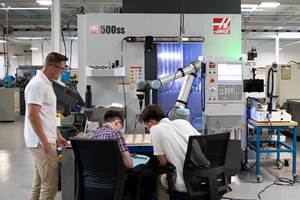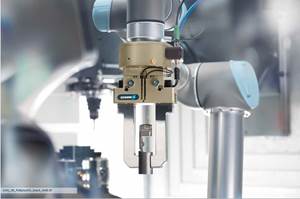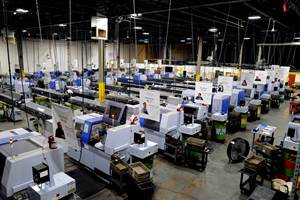Robots in Manufacturing: Advice, Predictions from Panelists
Part 1: TechSolve Inc.’s second robotics in manufacturing seminar focused on current and future applications for collaborative robots.
Share






Representatives from machine shops and automation integrators recently gathered at TechSolve Inc., a Cincinnati, Ohio-based manufacturing consultant with expertise in advanced machining for a half-day seminar on the Robotization of Manufacturing. It was the second in a series of seminars by TechSolve on robots, and the event included live demonstrations from presenters as well as a facility tour to see the company’s automation test bed.
Speakers shared their perspectives of robotics and automation in the industry, from workforce training concerns and personal success stories, to forecasts for the future of robotization and advice for shops looking to get started.
Why Robotics in Manufacturing Is Important
Not only is there a growing need for robots and automation in manufacturing, but there is also a growing desire from companies to make it happen.
One reason for this growth is competition with other world economies. According to Dr. Radu Pavel, TechSolve Inc.’s chief technology officer, U.S. manufacturers need to continue growing in the direction of robotics and automation to compete globally with countries like China. “Given what happens worldwide, given what happens in our own country, it is imperative that the small- and medium-size companies know what’s happening in the world and start developing this technology,” he said.
Mark Huffman, program manager for TechSolve’s collaborative robotics program, cited needs that were even closer to home. In February 2018, TechSolve conducted a poll of 1,500 Ohio manufacturers about their opinions on robotics and technology. The results, Mr. Huffman said, indicated that where robots are concerned, the majority of local manufacturers want to acquire this technology and learn more about what it can do.
Trends in Robotics and Automation
More specifically, several of the seminar speakers discussed applications and trends that can be seen in robotics right now, and that they predict will become more prevalent going forward. A few of these trends were machine tending, collaborative robots and mobile robots.
Collaborative robots, built to safely work alongside humans without cages or fencing, were on display at the seminar. TechSolve walked attendees through their test bed to see a force-torque-limiting collaborative robot from Universal Robots tending a CNC turning machine without a human operator. . showed a sample of a collaborative robot the company used with a real client to load automotive parts into a gage to measure for defects.
The speakers seemed to agree that collaborative robots, or “cobots,” are the future of manufacturing, but they were mixed in the tone of their comments.
For example, Paul Carrier, technical sales manager at , offered a caution regarding the safety element to the robots. “Collaborative robots are a bit of a misnomer,” he said. “There are no collaborative robots. There are only collaborative applications.” For example, a robot wielding a blade or torch would no longer be collaborative. Safety concerns still need to be considered for collaborative robots, because depending on what tool you use with the robot, fencing or other guards may still be required.
However, Michael Bruns, president of Arnold Gauge Co., had a tone that was more fully positive. “Collaborative robots empower or replace operators, allowing operators to do different things. That’s what we see in the industry,” he said. “Collaborative robots, they’re low cost, they’re flexible, they’re a key component in our solutions. And they’re something that we didn’t see five or 10 years ago. They’re becoming what we do.”
Mr. Huffman and Mr. Carrier both said machine tending will continue to be key research areas in robotics. Mr. Carrier said his company will soon be installing a mobile robot, a wheeled robot with the ability to move around autonomously, that they will program for machine tending as well.
How to Get Started in Robotics
Speakers also offered advice for how companies can get started in robotics right now.
The first and most important step, according to Mr. Huffman and Mr. Carrier, is to plan out the entire process that the robot will be performing. Mr. Huffman advised a rigorous evaluation phase to map out every step of the process and every interaction, with human or machine, that the robot will be making.
“Know what you want to do, know what your starting point is and what your goal is with the system,” Mr. Carrier said.
Another word of advice: “Start with success.” Mr. Carrier advised that shops begin with their simplest application, not their most difficult. “If this is your first robot that you’re going to be integrating, start with an application that you’re confident can be done and can be automated,” he said.
Finally, don’t be afraid of robotics. Mr. Huffman assured that robot operation and programming is learnable by most skilled technicians. The cobot attendees watched was, he said, the first experience with robots for many of TechSolve’s operators. “Once they found that the robotic language was very similar to the CNC language, it kind of clicked with them,” he said.
This is Part One of coverage from the Robotization in Manufacturing seminar, hosted by TechSolve. Read Part Two here.
Related Content
CNC Machine Shop Honored for Automation, Machine Monitoring
From cobots to machine monitoring, this Top Shop honoree shows that machining technology is about more than the machine tool.
Read MoreLean Approach to Automated Machine Tending Delivers Quicker Paths to Success
Almost any shop can automate at least some of its production, even in low-volume, high-mix applications. The key to getting started is finding the simplest solutions that fit your requirements. It helps to work with an automation partner that understands your needs.
Read MoreInside the Premium Machine Shop Making Fasteners
AMPG can’t help but take risks — its management doesn’t know how to run machines. But these risks have enabled it to become a runaway success in its market.
Read MoreCutting Part Programming Times Through AI
CAM Assist cuts repetition from part programming — early users say it cuts tribal knowledge and could be a useful tool for training new programmers.
Read MoreRead Next
AMRs Are Moving Into Manufacturing: 4 Considerations for Implementation
AMRs can provide a flexible, easy-to-use automation platform so long as manufacturers choose a suitable task and prepare their facilities.
Read MoreLast Chance! 2025 Top Shops Benchmarking Survey Still Open Through April 30
Don’t miss out! 91ÊÓƵÍøÕ¾ÎÛ's Top Shops Benchmarking Survey is still open — but not for long. This is your last chance to a receive free, customized benchmarking report that includes actionable feedback across several shopfloor and business metrics.
Read MoreMachine Shop MBA
Making Chips and 91ÊÓƵÍøÕ¾ÎÛ are teaming up for a new podcast series called Machine Shop MBA—designed to help manufacturers measure their success against the industry’s best. Through the lens of the Top Shops benchmarking program, the series explores the KPIs that set high-performing shops apart, from machine utilization and first-pass yield to employee engagement and revenue per employee.
Read More.jpg;width=70;height=70;mode=crop)





















